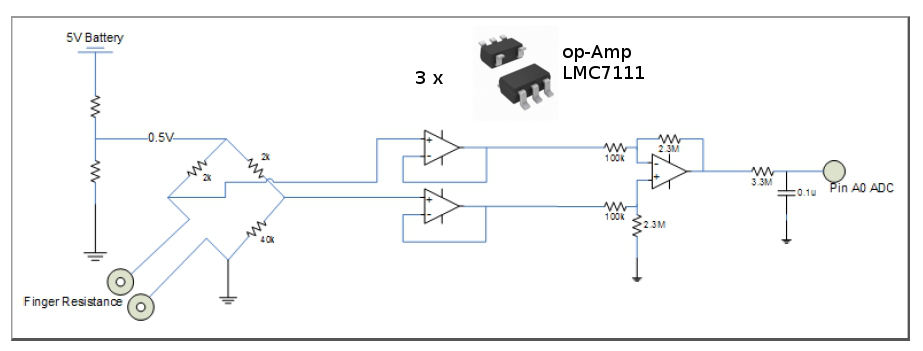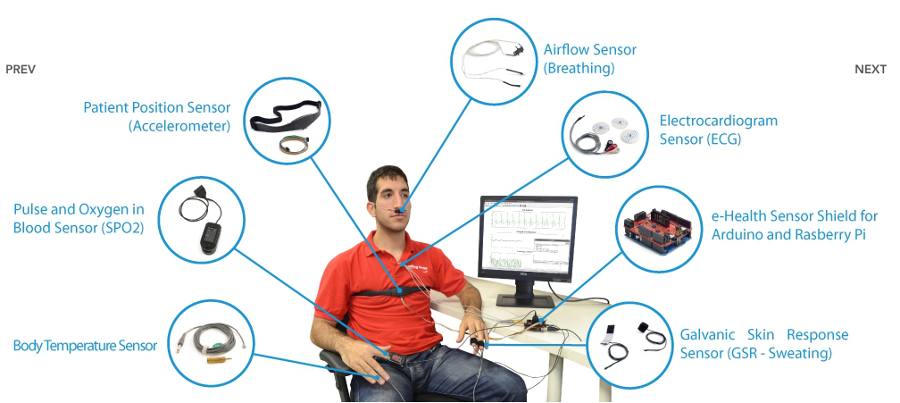
My final project is a dispositive that codifies and transmits NON CONSCIOUS body information such as: sweat, heart rate and eye blinking. The project seeks the augmentation of human experience through wearable physiological technology. It wishes to bring something private, namely our thoughts and emotions, and broadcast them to the world, through a screen placed in the chest:

Especially as much of our daily communication is moving away from face-to-face contact, we need new ways of expressing and transmitting our emotions to our peers. The project also relates to the work of Antonio Damasio who states that "The emotions come before feelings": Emotions are based on internal body environment which act as inputs into the brain, just as visual or auditory information is an input to the brain from the external environment. So the project will try to gather this previous-conscious world to interact with it, in ways yet not developed. Which might go from self-psicoanalisis to performance or visualizations.

Teletubbies have this square in the chest, wich could be seen as a window to their unconcious status, like an X-ray image of their feelings... this information could be screened locally in the chest or broadcasted to the internet.
This project have three inputs that gather this unconcious status: Eye blinking, galvanic skin response and heart rate:
This board is based in the hello.button hello.button example made in class, but the button is replaced by my eyelash. The idea is to close the circuit when the eyes are closed, with the contact of the copper eyelash. When the eye is closed a 1 is sent through the serial and while it remains open a 0 is sent.

I didn´t found any example of measuring the blinks of the eye, so I have to say this could be a new approach.
Skin conductance is known to be correlated with an individual's emotional state. It is often used in psychology for quantifying a person's reaction to different stimulus. It is also often implemented in a traditional lie detectors. The current theory is that a person under arousal generates sweat at the skin that changes the skin's electrical properties.
These are the best links that I found in the web about this issue: GSR reader Galvanic skin response And here is where I took from the final schematic and the list of components needed.

This project is based on the principle of photoplethysmography (PPG) which is a non-invasive method of measuring the variation in blood volume in tissues using a light source and a detector. Since the change in blood volume is synchronous to the heart beat, this technique can be used to calculate the heart rate. the light source and the light detector are both placed on the same side of a body part. The light is emitted into the tissue and the reflected light is measured by the detector.

The detected light reflected from or transmitted through the body part will fluctuate according to the pulsatile blood flow caused by the beating of the heart.
The PPG signal has two components, frequently referred to as AC and DC. The AC component is mainly caused by pulsatile changes in arterial blood volume, which is synchronous with the heart beat. So, the AC component can be used as a source of heart rate information. This AC component is superimposed onto a large DC component that relates to the tissues and to the average blood volume. The DC component must be removed to measure the AC waveform with a high signal-to-noise ratio. Since the useful AC signal is only a very small portion of the whole signal, an effective amplification circuit is also required to extract desired information from it.

The sensor used in this board is TCRT1000, which is a reflective optical sensor with both the infrared light emitter and phototransistor placed side by side and are enclosed inside a leaded package so that there is minimum effect of surrounding visible light. The circuit diagram below shows the external biasing circuit for the TCRT1000 sensor. Pulling the Enable pin high will turn the IR emitter LED on and activate the sensor. A fingertip placed over the sensor will act as a reflector of the incident light. The amount of light reflected back from the fingertip is monitored by the phototransistor.

It exists an e-health Sensor Shield that allows Arduino and Raspberry Pi users to perform biometric and medical applications where body monitoring is needed by using 9 different sensors: pulse, oxygen in blood (SPO2), airflow (breathing), body temperature, electrocardiogram (ECG), glucometer, galvanic skin response (GSR - sweating), blood pressure (sphygmomanometer) and patient position (accelerometer):

This is the BOM for the project:

The green elements are not included in the inventory so I bought them in DigiKey
The physical part of the project has been evolving since the very begining, right now as shown in this page first scheme, it will be displaced to one side of the head, between the eye and the ear. This new enclosure has not been developed yet. I leave here som pics with the evolution:



To make the enclosure I will follow the same steps and materials used in molding and casting week.